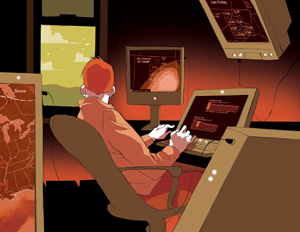Human beings are the big question mark for climate modelers
Tomer Hanuka |
|
 |
|
By LOUIS BERGERON
“Before we’ve modeled a thing about the climate itself, we have to model human behavior,” says Stephen Schneider, PhD, a climate scientist and policy analyst who’s been working on climate change issues since 1970, when he helped pioneer the discipline by co-authoring the first published climate modeling review paper.
“We know that there are going to be more people in the world,” Schneider says, alluding to our seemingly relentless drive to reproduce. Conventional wisdom holds that more people means more fossil fuel use, generating more carbon dioxide, which is the main culprit in global warming. But the bigger question is how much we’ll each pump out, especially those of us in affluent countries, where our per-capita carbon footprint looks like a massive dinosaur’s alongside an individual’s from a poor country — a comparison that could prove rather apt for our present lifestyle.
|
||||||||||||||||||||
To estimate the impending temperature rise, researchers use climate models built from meteorological and oceanographic data. Then they test how closely a model’s output matches reality, using relatively recent records as well as paleoclimate data from sources such as tree rings, sediment layers, ice cores and fossil seashells, which let them peer as much as several hundred million years into the past. The more data they have to test with, the more confidence in the model.
Schneider, a professor of biological sciences and a senior fellow at Stanford’s Woods Institute for the Environment, says climate models do a pretty good job of estimating temperature trends on a global scale over time frames of decades, but it’s tougher to do the same with a high level of confidence for rainfall. Both rainfall and temperature are hard to estimate confidently for smaller regions or shorter time frames. Also, different models produce different degrees of climate sensitivity — the amount of temperature rise for a given increase in carbon dioxide — so temperature projections must be given as a range.
These limits make it difficult to plan effective strategies to reduce potential warming by any specified target amount. Climate policy analysis is more akin to choosing insurance — buying protection against the estimated probability of a big risk. And there are misconceptions to clear up, like the notion of a “tipping point,” where the global temperature gets high enough that suddenly it’s out of control and Earth just keeps getting hotter. Still, real temperature thresholds do exist for certain smaller systems such as coral reefs, for example.
Schneider says we can’t let short-term failures to control emissions keep us from taking on the larger issue, as our (in)action to date has effectively committed us to at least another degree of temperature rise. “It’s too late to prevent some damage,” he says. “But it’s not even remotely too late to prevent some of the really big catastrophic long term stuff, if we get our act in order.”
Comments? Contact Stanford Medicine at

